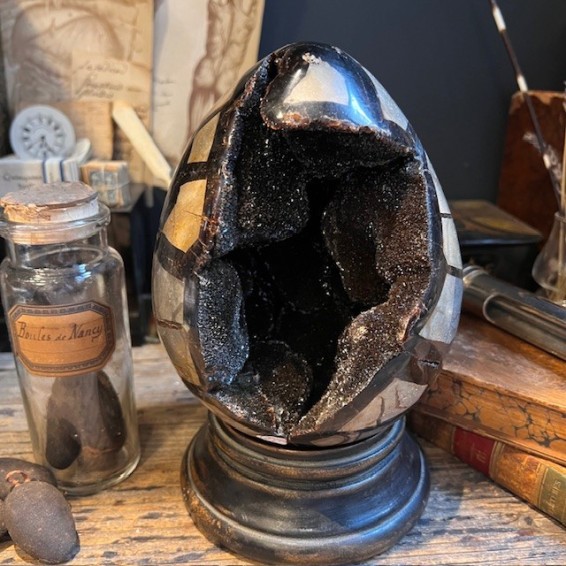
Display for ball or ostrich egg (Large)
High base specially designed to hold a ball or egg
Perfect for ostrich eggs
Not suitable for emu, rhea or swan eggs, for example











Dragon Stone
Septaria egg of Madagascar
Septaria Madagascar egg
Also known as Dragon Stone
Septaria is a stone composed of a mixture of yellow calcite and sandstone, found mainly on the island of Madagascar, characterized by highly visible shrinkage cracks. These highly visible cracks, known as Septa, fill with minerals over time.
When the stone is polished, these cracks stand out, giving it a dragon's egg appearance on the outside.
With time, tectonic movements, etc., the nodules can be fractured and new mineral solutions can invade the shrinkage cracks, often calcite.
In our case, Septaria has been polished into an egg shape and the interior has been invaded by a very fine crystallization of calcite. Beautiful crystals.
It's also easy to see why it's called Dragon's Stone: the exterior is very similar to a dragon's egg!
Sold without base
Ref OSM164: Weight: 2.65kg - Height: 16cm
Sold without the base
You can find available bases by typing ball base or egg base in the site search.
High base specially designed to hold a ball or egg
Perfect for ostrich eggs
Not suitable for emu, rhea or swan eggs, for example
Wooden base for ball or sphere - Base - support
Grey-Black patinated marble base for ball or sphere
Base - support
Aïtos Protective ancestor totem from Timor (Indonesia) with crocodile effigy
Column statue from Indonesia
Mounted on base: 2.70m high
Memento Mori sculpted from a deck of cards - Poker
Size S
RED color
Madagascar sawyer ammonite - Cleoniceras fern ammonite
Cleoniceras fern ammonite
100 million year old fossil
Entomological box
Butterflies: Asian Papilio
Papilio ulysses - Papilio blumei - Papilio maackii
Entomological box
Composition with South American butterflies
Morpho and heliconius
L'École du pharmacien - Eléments de matière médicale
The School of Pharmacy - Elements of Medical Science
By J. Léon Soubeiran
Published in 1878 by J. Rothschild, Publisher
Work illustrated with 547 black and white vignettes in the text
The human body - Anatomy of Man
Removable anatomical board
circa 1900 by VIGOT Frères éditeurs
Colored loose-leaf board, cut out and superimposed
Some traces of adhesive on certain organs such as the liver, for example, but not much
Herbalist's or Pharmacist's jar
Antique blank label of the XVIIIth century
Atlas of descriptive anatomy of the human body
Anatomy board
By Doctors Bonamy and Paul Broca
Draftsman: Emile BEAU
Published on July 1st 1854
Megalodon tooth fossil - Otodus megalodon
11.8cm
Indonesia
Fossil shark tooth
Antique bezoar - Antipoison - Antidote
Once sold by the apothecary, bezoar, also known as gallstone, was reputed to have the same anti-poison properties as the legendary unicorn's horn, hence its excessively high price, also due to its great rarity.
An important piece in a cabinet of curiosities
Sold alone - Without stand, sold separately
Anatomic lithography: "Traité complet de l'Anatomie de l'Homme"
by Dr Bourgery and draughtsman Jacob
Volume 3 - 1844
168: Hydrangea arborescens Annabelle
Real framed and calligraphed Herbarium
Manuel complet de Physique et de Météorologie - Complete Manual of Physics and Meteorology
By Ajasson de Grandsagne and L. Fouché
Second edition published in Brussels in 1835
Illustrated with 6 folding plates depicting more than 250 figures. (torn: see photos)
Antique pharmacy display jar
Blown red glass

Dragon Stone
Septaria egg of Madagascar










